#Chancellery Museum
Text
What’s that elephant the Danes are wearing?

Tatler’s guide to the emblems and quirks of Denmark’s highest honour, the Order of the Elephant.
A curious little diamond-encrusted elephant, a blue sash, a gold collar – and sometimes a big flaming cape…Tatler looks into the history and tradition of Denmark's most privileged Order.
With Frederik X set to become sovereign of the Order as he becomes King on Sunday, you might see a few of these elephants around Copenhagen's royal palaces
By Isaac Zamet
12 January 2024
When Crown Prince Frederik becomes Frederik X of Denmark on Sunday, he will also replace his mother, Queen Margrethe II, as the sovereign of Denmark’s most ancient and distinguished order of chivalry, the Order of the Elephant.
Though it was officially refounded in 1693, the order dates all the way back to the 1400s, when it was established as a religious confraternity by a group of about fifty Danish knights.
In the 1400s, prior to the Reformation which gripped Europe and divided the church, such religious ‘clubs’ as the Order of the Elephant were common features of aristocratic life.
At the time of the Order of the Elephant's birth, Christian I was King of Denmark – and in fact, Norway and Sweden too, creating a personal union known as the Kalmar Union.
During this period, the emblem of the club was an image of the Virgin Mary holding her Son within a crescent moon.
This was hung from a collar formed of links in the shape of elephants.
The confraternity mutated over the centuries but endured a stifled period after the Reformation in which such clubs became suspect.

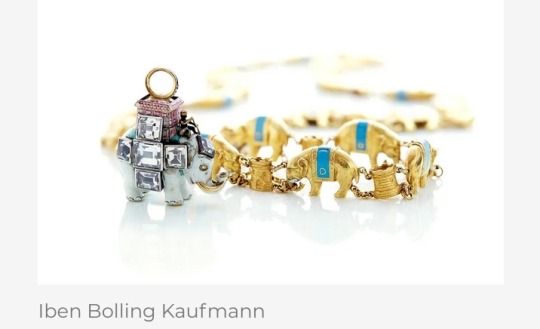
In 1580, Frederik II – eight Frederiks prior to our current Frederik – revived the order and replaced the medallion of the mother and child with an elephant (a Reformation-safe, Protestant approach – if a quirky one!).
But it was Christian V, in 1693, who gave the club its official statues and founding order.
At this time, it was scheduled as comprising 30 noble knights and one Grand Master (the King) along with his sons.
It was only in 1958 that the statutes were amended by Royal Ordinance to allow the ennoblement of women as members of the order.
Between 1580 and today, around 890 persons have been bestowed with the Order of the Elephant; with Queen Margrethe adding 68 people during her 40 year reign.
The recipients are almost always royal persons and foreign heads of state – though in a rare exception, the order was given to a commoner in 2000.


This was the deceased shipping magnate, Mærsk Mc-Kinney Møller, who was recognised for exceptional contribution to Danish economic strength and Danish society.
Those unfamiliar with the man himself will surely recognise his name from the famous shipping containers.
The A.P. Møller – Mærsk group was actually founded in 1904 by his father. It is now worth $81bn dollars.
At the time of Møller’s membership of the order, he was the only non-royal and non-head of state to hold the honour; though it had previously been held by the pioneering nuclear physicist, Niels Bohr.
Membership of the order comes with possession of its rather eye-catching elephantine emblem.
The elephant is made of white-enamelled gold with blue housings and is about 5cm high.

On its back, the elephant bears a tower of pink enamelled masonry (a design originally intended to reflect the howdah compartments of the Indian subcontinent).
A number of large cut diamonds adorn the elephant, along with a crowned monogram of the monarch reigning when it was made.
One wonders, then, when the first Frederikian elephants will be carved.
At the top of the tower on the elephant’s back sits a gold ring, from which the badge can be hung from the collar or tied to a sash.
On the elephant's back sits a turbaned ‘moor mahout.’
It should be noted that some would regard such a depiction as an exoticising caricature.
Others would regard its appearance merely as an expression of an historical perspective.

One striking detail about the circulation of the elephants is that each Order of the Elephant is – in principle – on loan and must be returned to the Chapter of the Royal Orders of Chivalry when a member of the Order has passed away.
This rather quaint custom means that elephants are inherited and used several times by different members of the order, with some dating back hundreds of years.
Interestingly, the done thing is not to disclose to whom an Elephant has previously been given – though there are some traditional lines of inheritance.
For example, the elephant recently bestowed on Prince Christian belonged previously to his grandfather, Prince Henrik.
This handing over was always to be, on the basis of a traditional line of inheritance.
There are two exceptional elephants which have eluded the rule of the ‘loan’ – one remains in the Chancellery Museum at Paris and a second remains on display at the Dwight Eisenhower Presidential Library in the US.
Another beautiful quirk of membership of the Order is that a member’s coat of arms is always painted and subsequently hung in the Knight’s Chapel at Frederiksborg Castle in Hillerød.
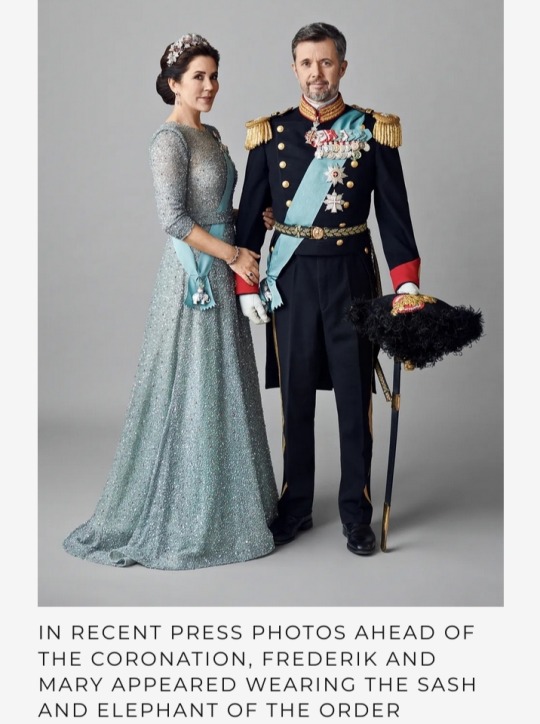
As to when the elephants come out to play, there are some rather interesting traditions concerning how and when to wear them.
The Order of the Elephant has three festival days: new year’s day, the monarch’s birthday, and the birthday of Valdemar the Victorious, which, if you didn’t know is on June 28.
On these festival days, the Order of the Elephant is worn on the chest on a gold chain link collar, with links shaped as towers and elephants.
The collar sits on each shoulder. On other important occasions, the order is worn on a bright blue sash with a breast star.
The star of the order is an eight-pointed silver star with smooth rays; at its centre sits an enameled red disc with a white cross, surrounded by a laurel wreath in silver.
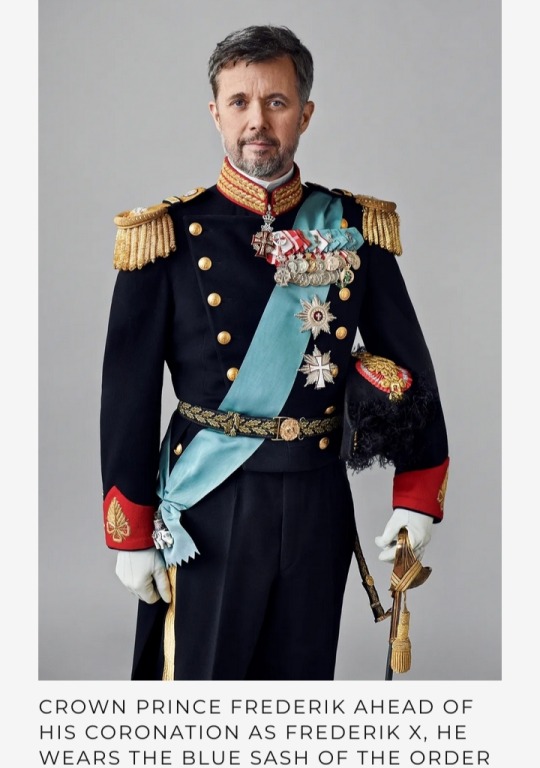
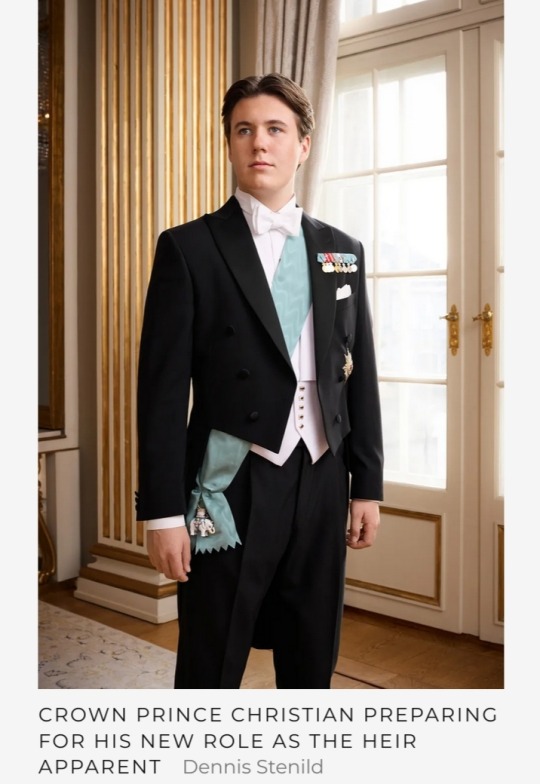
#Frederik X#Queen Margrethe II#Monarchy of Denmark#Danish Royal Family#House of Glücksburg#Christian I#Kalmar Union#Order of the Elephant#Frederik II#Christian V#Mærsk Mc-Kinney Møller#Frederikian elephants#Chancellery Museum#Dwight Eisenhower Presidential Library#Knight’s Chapel#Frederiksborg Castle#Crown Prince Christian of Denmark#Queen Mary of Denmark
31 notes
·
View notes
Text
The Wannsee Conference

These are some facts and curiosities about The Wannsee Conference:
On January 20, 1942, fifteen top officials of the Nazi Party and the German government gathered in a villa in the Berlin suburb of Wannsee to discuss the execution of what was called the "Final Solution to the Jewish Question."
The men gathered at Wannsee never questioned whether the plan should be implemented or not, but worked directly on identifying the most suitable systems to put it into practice.
Despite the various euphemisms used in the meeting protocols, the purpose of the Wannsee Conference was always clear to its participants: to coordinate the actions that would lead to the complete elimination of all the Jews of Europe.
The meeting took place on the scheduled day in the offices of the Rsha, Am Großen Wannsee, n. 56/58, with the following speakers:
Dr. Alfred Meyer, Gauleiter, State Secretary and Deputy Minister.
Dr. Georg Leibbrandt, director of the political department at the Ministry for the Occupied Territories in the East.
Dr. Wilhelm Stuckart, State Secretary for the Reich Interior Ministry.
Erich Neumann, Secretary of State, plenipotentiary for the four-year plan.
Dr. Roland Freisler, State Secretary at the Reich Ministry of Justice.
Dr. Josef Bühler, State Secretary of the General Government.
Martin Luther, undersecretary (Unterstaatssekretär) of the Foreign Ministry.
SS-Oberführer [Dr.] Gerhard Klopfer, permanent secretary of the party chancellery.
Friedrich Wilhelm Kritzinger, permanent secretary of the Reich Chancellery.
SS-Gruppenführer Otto Hofmann, head of the Central Office for Race and Colonies (RuSHA).
SS-Gruppenführer Heinrich Müller, commander of the Gestapo.
SS-Obersturmbannführer Adolf Eichmann, head of department IV B-4 of the RuSHA, secretary of the conference.
SS-Oberführer Dr. Karl Eberhard Schöngarth, commander of the SiPo and the SD (BdS) in the General Government.
SS-Sturmbannführer Dr. Rudolf Lange, commander of the SD (KdS) in Latvia, representative of the SiPo and the SD (BdS) in the Reichskommissariat Ostland.
SS-Obergruppenführer Reinhard Heydrich, director of the Rsha and Reichsprotektor of Bohemia and Moravia.
Sources:
United States Holocaust Memorial Museum
Wikipedia: The Wansee Conference
I DON'T SUPPORT NAZISM,FASCISM OR ZIONISM IN ANY WAY, THIS IS AN EDUCATIONAL POST
#reichblr#ww2 germany#ww2 history#studyblr#austrian painter#the ss#reinhard heydrich#wansee conference#adolf eichmann
11 notes
·
View notes
Text
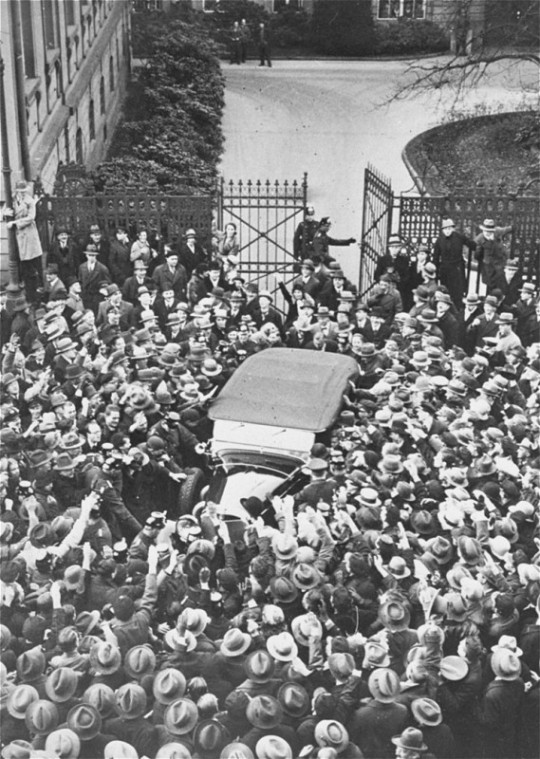
A crowd of cheering Germans surrounds Adolf Hitler's car as it leaves the Reich Chancellery after a meeting with President Paul von Hindenburg. Berlin, Germany, November 19, 1932.
Source: United States Holocaust Memorial Museum
I DON'T SUPPORT NAZISM,FASCISM OR ZIONISM IN ANY WAY, THIS IS AN EDUCATIONAL POST
10 notes
·
View notes
Text
A man who was three years old when his father – an American intelligence – sent him a letter on a vanquished Adolf Hitler’s stationery has declared himself disgusted by US extremist groups who still admire the former Nazi ruler.
“Those people have no idea – the history and foulness of that,” Dennis Helms, the son of the late Richard Helms, the CIA director from 1966 to 1973, said of the presence of neo-Nazis and antisemitism in the US. “There can be nothing that’s worse … I can’t say enough bad about that.”
Helms’s remarks came in an interview with the Guardian as the US prepared to observe Tuesday’s 79th anniversary of D-day, when Allied troops landed on the beaches of Normandy to help liberate north-west Europe from Nazi Germany’s control.
The military campaign started by that invasion culminated in Germany’s surrender on 8 May 1945, a little more than a week after the suicide of Hitler, who oversaw the murders of 6 million Jews during the Holocaust, among other atrocities.
“The man who might have written on this card once controlled Europe – three short years ago when you were born,” Richard Helms’s letter to Dennis read. “Today he is dead, his memory despised, his country in ruins.”
The letter went on to describe how thousands of people died as a result of their efforts to put a stop to Hitler, who “had a thirst for power, a low opinion of man … and a fear of intellectual honesty”.
“The price for ridding society of bad is always high,” Richard Helms’s letter added in closing. “Love, Daddy.”
Dennis later learned that his father had apparently actually interviewed Hitler while covering the 1936 Olympics in Berlin as a reporter during a previous career. According to his son, Richard was always proud to have personally seen Black American runner Jesse Owens win the 200-yard dash at those games, frustrating Hitler’s dreams of a competition dominated by white athletes.
Now 80, Dennis later provided his father’s V-E Day letter to the CIA, the successor of the OSS, which Richard led during the presidencies of Lyndon Johnson and Richard Nixon. The CIA displays it in its private museum alongside other artifacts provided by Richard Helms’s family, including a dinner plate from Hitler’s chancellery that he acquired during a trip to Berlin in September 1945.
The letter which Richard – who later also served as the US ambassador to Iran – wrote Dennis has been publicized before. A picture of its contents went viral on social media on the most recent V-E Day anniversary.
However, just two days before that, a man clad in extremist insignia and having a history of praising Nazis online shot eight people to death at a mall in Texas. And late last year, Joe Biden had the occasion to release a statement saying “the Holocaust happened” and “Hitler was a demonic figure” after Kanye West, who has changed his name to Ye, earned a suspension from Twitter by speaking approvingly of the Nazi ruler and publishing an image of a swastika blended with a star of David.
7 notes
·
View notes
Text


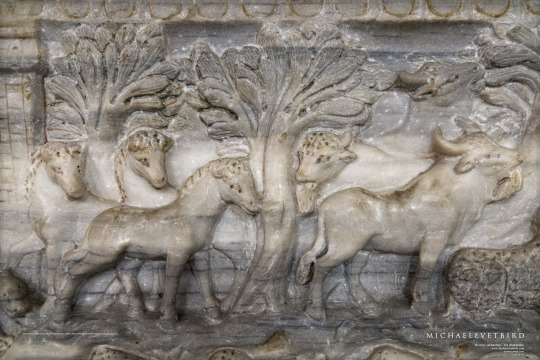
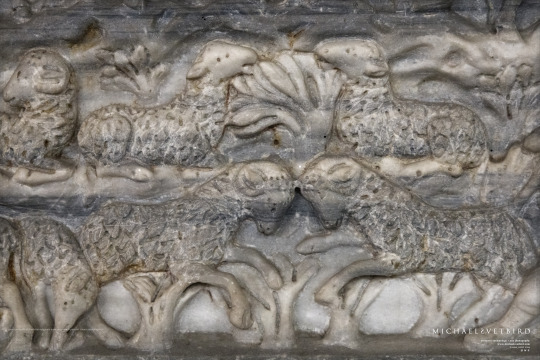
'NATURE':
"Gigantic Sarcophagus With Pastoral Scenes",
Roman,
Ca 270 AD.
[From the area near the Thermae of Caracalla, Rome]
"The dedication is placed to Iulius Achilleus by his wife.
Achilleus had been conferred the title of vir perfectissimus, and was a person in charge of an office in the imperial chancellery [proximus a memoriae] and after he went on to become super-intendant [procurator] of the gladiatorial barracks of Rome [Ludus Magnus]."
[txt ©Epigraphic Museum, BOD MNR]
Epigraphic Museum at Baths of Diocletian, Museo Nazionale Romano | BOD MNR
• Web : https://museonazionaleromano.beniculturali.it/en/baths-of-diocletian
• FB : https://www.facebook.com/MNRomano
• IG : @museonazionaleromano
BOD MNR | Michael Svetbird phs©msp | 06|23 6240X4160 600 [I.-IV.]
The photographed object is collection item of BOD MNR, photos are subject to copyrights.
[non commercial use | sorry for the watermarks]
Featured in Antiqvvs Magazine Summer 2023 Issue
https://www.antiqvvs-magazine.com
📸 Part of the "SARCOPHAGI:Reliefs" MSP Online Photo-gallery:
👉 D-ART:
https://www.deviantart.com/svetbird1234/gallery/69396046/sarcophagi-reliefs
👉 FB | Album:
https://www.facebook.com/media/set/?set=a.843393602695885&type=3
.
#rome#baths of diocletian#epigraphic#museum#archaeological museum#museo nazionale romano#roman#sarcophagus#sarcophagi#reliefs#frieze#sculpture#ancient sculpture#ancient rome#ancient art#antiquity#archaeology#ancient#heritage#museology#art history#antiquities#mythology#photo gallery#photography#sculpture photography#art photography#archaeology photography#museum photography#michaelsvetbird
2 notes
·
View notes
Photo
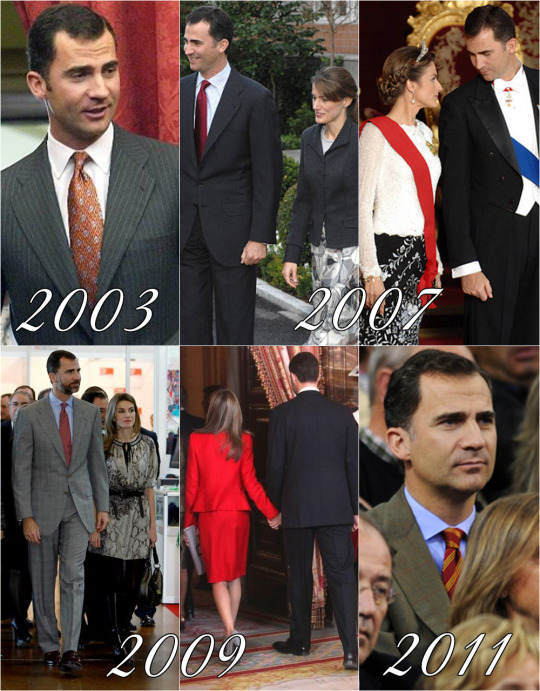

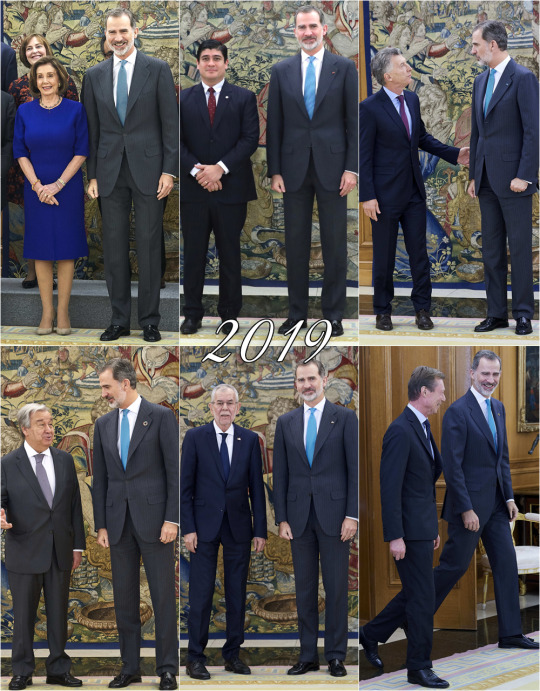

Felipe and Letizia retrospective: December 3rd
2003: Opening of the 8th Iberoamerican Congress of Constitutional Law. Universidad de Sevilla
2007: Lunch & Gala dinner offered to the president of the Philippines Gloria Macapagal-Arroyo
2009: Opening of the 12th State Volunteer Congress & Reception on the occasion of the Conference of Presidents of the European Parliament
2011: Doubles match between David Nalbandian and Eduardo Schwank of Argentina and Feliciano Lopez and Fernando Verdasco of Spain on day two of the final Davis Cup match between Spain and Argentina in Seville.
2012: Antena 3 Foundation meeting in Madrid.
2013: Delivery of the International Spanish Architecture Awards and the Medals of the Superior Council of the Spanish Architects’ Colleges in Madrid
2014: Oath of the new Minister of Health, Social Services and Equality, Alfonso Alonso Aranegui at la Zarzuela in Madrid.
2015: Visited the new headquarters of the Chancellery of the Royal and Military Orders of San Fernando and San Hermenegildo in Madrid
2018: Audience to the Advisory Council of the General Courts for the commemoration of the 40th anniversary of Spanish Constitution at El Pardo Palace & ‘Poeticas de la Democracia. Imagenes y Contraimagenes de la Transicion’ exhibition at the Reina Sofia museum (1, 2, 3)
2019: Audiences with Nancy Pelosi, Speaker of the US House of Representatives; the President of Costa Rica; the President of Argentina; Antonio Guterres, Secretary-General of the United Nations; the President of Austria; Lunch with Grand Duke Henri of Luxembourg; COP25 Climate Summit & Gala dinner for the awardees of “Mariano de Cavia”, “Luca de Tena” and “Mingote” awards
2020: Inaugurated the “Rafael en Palacio. Tapices para Felipe II” at the Royal Palace & Board meeting of the Carolina Foundation
2021: Visited Colombia to attend the World Law Congress Colombia 2021.
F&L Through the Years: 882/??
#King Felipe#Queen Letizia#King Felipe of Spain#Queen Letizia of Spain#King Felipe VI#King Felipe VI of Spain#F&L Through the Years#December3
1 note
·
View note
Text
Enjoy your 3-hour bike tour in Berlin, taking in this remarkable city's rich history, fascinating landmarks, and vibrant atmosphere!
Description of a 3-hour Explore of Berlin's Historical Highlights, iconic landmarks, and points of interest as you pedal or ride in the Rickshaw.
We provide comfortable rickshaws with skilled and safe drivers for participants who prefer to avoid biking.
Berlin By bike tour and Rickshaw program.
Duration: 3 hours
Through the Tiergarten Park, we, in the direction of Victory Column, Bellevue, and Haus der Kultureren der Werlt, appreciate the surroundings and prepare for the adventure's next leg, Among River Spree.
Chancellery Berlin and Reichstag and Government Area: Continue the tour by picturing Chancellery Berlin, the official residence of the German Chancellor, and the Reichstag and Government Area. Your guide will share fascinating insights into the history and significance of these sites.
Brandenburger Tor and Unter den Linden: Pedal your bike or enjoy a rickshaw ride to the famous Brandenburger Tor, a symbol of Berlin and a significant historical monument. From there, explore the grand boulevard of Unter den Linden, lined with notable buildings and landmarks.
Bebelplatz (Square of Book Burning): Stop at Bebelplatz, known as the Square of Book Burning, where the Nazi regime burned books by Jewish and non-Aryan authors in 1933. Learn about the historical significance of this site and its impact on intellectual freedom.
Museum Island: Visit Museum Island, a UNESCO World Heritage Site, known for its exceptional ensemble of museums, including the Pergamon Museum, Bode Museum, and Neues Museum. Picture and inform you of this island's architectural beauty and cultural treasures.
Alexanderplatz and Gendarmenmarkt Berlin: Continue your bike tour or rickshaw ride to Alexanderplatz, a bustling square and transportation hub. Then, head to Gendarmenmarkt Berlin, one of the most beautiful squares in the city, flanked by impressive architectural landmarks.
Checkpoint Charlie and Holocaust Memorial: Explore Checkpoint Charlie, a former border crossing between East and West Berlin during the Cold War. Learn about its historical significance and the divided city.
Ministerium Airforce Hitler and the Topography of Terror provide insights into the crimes committed during the Nazi regime and the Berlin Wall.
Next, visit the poignant Holocaust Memorial, dedicated to the six million Jewish victims of the Holocaust.
Pass by historically significant locations such as the Führerbunker (parking place),
Potsdamer Platz and Tiergarten Berlin: Pedal or enjoy a rickshaw ride to Potsdamer Platz, a vibrant square with significant urban development. From there, venture into the expansive Tiergarten, Berlin's central park, known for its tranquil paths and beautiful landscapes.
Tiergarten Berlin: Immerse yourself in the beauty of Tiergarten, a vast urban park filled with lush greenery, serene lakes, and picturesque pathways. Enjoy a leisurely ride or a relaxing rickshaw journey through this tranquil oasis.
Remember, this is a tour in small groups, private Tours designed to your wishes and interests are on Request possible.
0 notes
Text
Emil Nolde

At the Emil Nolde Museum
Emil Nolde, who spent a lot of his time painting almost daily sunsets or his own garden rather badly than well, and who even made it into the German Chancellery with his choice of motifs, something that not every German painter can claim for himself, Emil Nolde, the expressionist German painter of flowers in his own garden, but also of landscapes with sunsets, is, I think, still today a very good example of someone who enthusiastically wanted to get together with the eternally cheeky, stupid German criminals and villains and get drunk and suppress others in the collective intoxication of power, but who completely overlooked the fact that in the vast majority of cases stupid German criminals are also often simply stupid German villains.
And so Nolde-Emil also ended up in the box with the other 'degenerates'...
In any case, Christies writes the following on the subject:
"The most expensive work by Emil Nolde in our database was auctioned at Christie's auction house on 06.10.2020 for $7,344,500. The distribution of prices shows that most works are in the price segment between $100,000 and $500,000"
But whether the Nolde emil fetches 100,000 these days because of his enthusiastic longing to hang out with the crooks and tell anti-Semitic jokes and let the Führer be a good man, or because (afterwards) he then hyped himself up as a poor victim of the evil Nazis,
well, we don't really know...
The most likely scenario is that the buyers of the colourful flowers or the sunsets with landscapes or the Vikings and the other grimaces
might not be that interested in the end...
The pure, superficial and hollow view of the garden or of the sunset over the German landscape, so completely beyond mass murder, Auschwitz and Stalingrad - perhaps this is precisely
expression of the actual cultural demand of the German bourgeoisie, or the bourgeois German "king".
bourgeois German "king" or the civil servant "customer", who is fascinated by crime, but who, sitting in his or her own garden, doesn't really want to have that much to do with all the rest...
In this sense, let's just hope that today's fellow travellers won't get it themselves one day - just like Emil, who basically just wanted to paint some flowers and landscapes and sunsets and, together with the other little men, only wanted to take part in a little Jew- and subhuman-bashing...
Translated with www.DeepL.com/Translator (free version)
Read the full article
0 notes
Photo

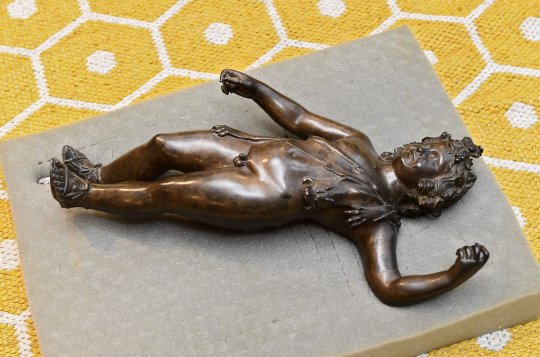
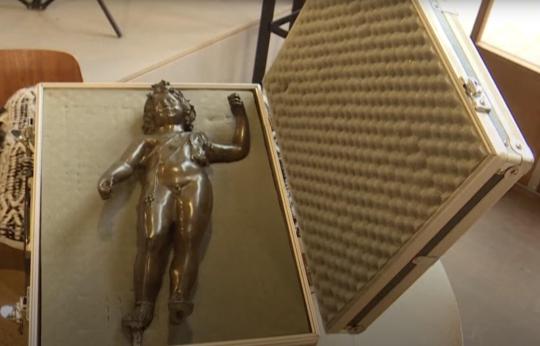
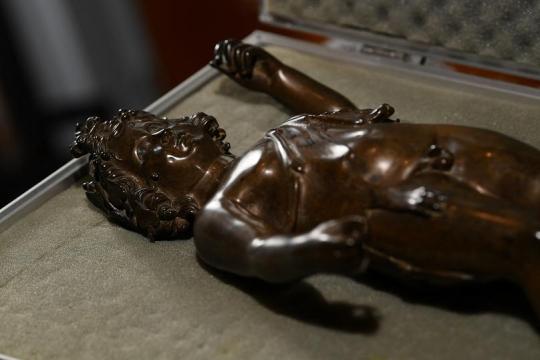


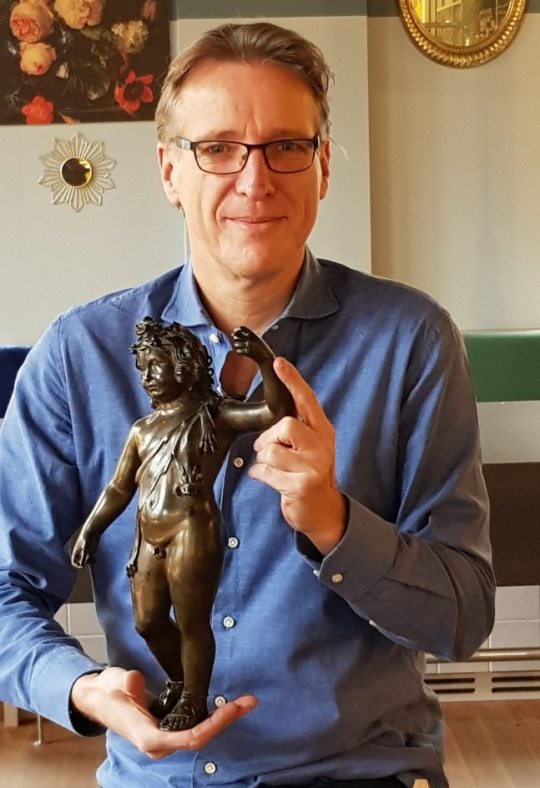
A Rare Roman Statue Stolen 50 Years Ago Found
A Dutch art detective, dubbed the "Indiana Jones of the Art World" for his exploits, has returned a rare Roman statue that was considered one of France's most important treasures before it was stolen nearly 50 years ago, to the museum from which it was taken.
Arthur Brand handed back the first-century bronze sculpture statue of the god Bacchus to the director of the Musee du Pays Chatillonnais in eastern France.
It was from there on a cold evening in December 1973 that thieves smashed a window, crawled through the bars and pilfered the 40-centimeter (15.7-inch) statue of the god of wine.
"The criminals made off with some Roman antiquities, around 5,000 Roman coins – but more importantly, the bronze statue of Bacchus as a child," Brand told Agence France-Presse (AFP).
"The loss to the museum and the community was enormous. One of their most precious antiquities has been stolen," said Brand, moments before handing back the statute in a ceremony at an Amsterdam hotel.
"Because back then there was no proper catalogue for stolen art, the statue disappeared into the underworld and was thought to have been lost for ever."
The director of the museum – famed for its collection of Roman artifacts from the nearby archaeological dig site of Vertillum, an ancient Gallo-Roman village first excavated in 1846 – said it was an emotional moment.
"When I saw it now for the first time, I just realised how much more beautiful it is than the copy we have had on display" since the original was stolen, Catherine Monnet told Agence France-Presse (AFP).
Hunt was on'
The statue resurfaced through sheer chance two years ago when an Austrian client contacted Brand, whose previous finds include a Picasso painting and "Hitler's Horses," sculptures that once stood outside the Nazi leader's Berlin chancellery.
The client asked the Dutchman to investigate a statue of a little boy he bought legally on the art circuit.
"When we could find no reference for such an important work existing anywhere, we realised that the work could have been stolen – and the hunt to find out what it is was on," said Brand.
After months of sleuthing, an obscure entry in a 1927 edition of a French archaeological magazine finally revealed a clue: the sculpture depicts Bacchus as a child and belonged to a French museum.
Further inquiries with French police revealed it was stolen on Dec. 19, 1973, according to an official police report of which AFP has seen a copy.
"This means we had to make a deal. The Austrian collector bought it legally on the open market where it had probably been sold more than once over the last few decades," the detective said.
Furthermore, the statute of limitations in France was five years, meaning that no criminal case could be opened, Brand said.
"But the owner was shocked to learn that the piece had been stolen and wanted to give it back to the museum. Under French law, he had to be paid a small amount – a fraction of the statue's price which could be millions of euros – for 'safekeeping,'" Brand said.
'French heritage'
Brand tapped into his extensive network, and two British art collectors, Brett and Aaron Hammond, sponsored half of the amount, while Chatillon's council paid the other of the undisclosed sum of money.
"After 50 years, it's extremely rare for a stolen object to surface. Especially such an important one, that's now going back to the museum where it belongs," Brand said.
Museum director Monnet was delighted to have the sculpture back.
"This is a particularly important art piece, because they are so rare and of such great quality," she said.
The statue was discovered by archaeologists in 1894 during a dig at the Vertillum site, already declared a historical monument two decades prior.
In 1937, the Bacchus statue formed part of an exhibition in Paris consisting of what was regarded as the 50 most beautiful art treasures of France, Monnet said.
"This just tells you how important this piece of art is as a part of France's heritage," she said.
"As for Arthur – he has free entrance to the museum for life," a beaming Monnet added.
#A Rare Roman Statue Stolen 50 Years Ago Found#The God Bacchus#art#artist#art work#art news#bronze statue#ancient art#ancient artifacts#history#history news#ancient history#ancient culture#ancient civilizations#roman history#ancient rome#roman empire
76 notes
·
View notes
Photo

In the best Viennese tradition Oswald Haerdtl (1899-1959) was more than an architect but a total designer, a Gesamtkünstler, whose postwar interiors epitomize the carefree spirit of the time. Haerdtl was trained at Vienna’s Kunstgewerbeschule by Oskar Strnad and Josef Frank, two protagonists of Austrian architecture who instilled a clear sense of modernism in the young architect. In 1924 he joined Josef Hoffmann’s atelier and became his long-term associate but never an epigone of the master. One of the most striking talents of Oswald Haerdtl was his ability to translate his design ideas, no matter if architecture, furniture, lettering or fixtures, into beautiful drawings on squared paper that also make up a good part of the present book: „Oswald Haerdtl - Architekt und Designer (1899-1959)“, edited by Adolph Stiller and published by Verlag Anton Pustet in 2000, is a comprehensive monograph and work catalogue that offers multifocal perspectives on his short but fruitful career. Friedrich Achleitner provides a very vivid account of Haerdtl’s role in Vienna’s architecture scene and the authority he undoubtedly was, also qua the important commissions he received, e.g. the postwar reconstruction of the Vienna Chancellery or the Wien Museum. Bruno Reichlin in turn elucidates his role as architect and designer of countless interiors, especially those of cafés and Espresso bars, designs that often only in retrospect received their due appreciation as ingenious representations of their times. Haerdtl’s architecture, as Siegfried Mattl points out, is one of subtle differences, of serene nobility, characteristics perfectly embodied by his Austrian pavilion at the 1937 world fair in Paris, a transparent rectangle so much more subtle than the brutally pompous pavilions of the USSR or Germany.
„Oswald Haerdtl - Architekt und Designer“ is a fabulous, in-depth monograph on an often overlooked but undoubtedly important architect both in interwar and postwar Austria who with the present book received a long overdue appreciation.
28 notes
·
View notes
Text
Festetics Palace




Festetics Palace is located in the town of Keszthely in Zala, Hungary. Kristof Festetics began construction on the Baroque castle in 1745. The Festetics family is one of the most significant ducal families in Hungary. In 1759, Kristof had a hospital established in the town. Kristof’s son Paul III became Court Chancellery, the Queen’s Confidential Advisor, and Vice-President to the Hungarian Chamber. He also founded the first primary and second schools of Keszthely. Paul’s son, George I, also made significant contributions to the area by establishing the first agricultural college in Europe, commissioning the vessel Phoenix Galley, and more. The U-shaped palace has 100 rooms, but it has been rebuilt, reconstructed, and enlarged throughout its history. George added an opulent library wing to the palace. The library consists of more than 86,000 items and is open to the public Monday-Friday, where books can be read onsite for a fee. George’s great-grandson, Tassilo II, was considered the “greatest Hungarian aristocrat.” He was Royal Court Chamberlain, Privy Councilor, and Lord Steward. He married English Princess Mary Hamilton and received the title of Prince by Emperor Franz Joseph. Between 1883-1887 Tassilo II had the northern wing of the castle demolished and a new one built with a turreted central section, almost doubling the size of the palace. He had the mansard roof added, along with central heating and plumbing. The Festetics family left the palace in 1944, likely due to Jewish deportations in their town. The Festetics were responsible for building the first synagogue in Keszthely in 1780. Although the history appears to be avoided, Jews with Hungarian surnames lived in Keszthely since 1735 under the local aristocrat protection like the Festetics family. In the summer of 1946, the palace served as a public agricultural school. The property belonged to the Festetics family until nationalized by the Communists in 1949. Festetics Palace is surrounded by a nature preserve that includes a pond, fountains, statues, and flowerbeds. The palace is Hungary’s third-largest in size and the most touristed. The property has the 1880 Palm House, which serves as a type of orangery, and many exhibitions, including the former coach house exhibition, a hunting exhibition, and the historical model railway exhibition near the back gate of the park. The palace houses the Helikon Palace Museum and serves as an events venue. #Castles #Palaces #FesteticsPalace #Hungary #Keszthely #Zala #HelikonPalaceMuseum #venue #Museum
#CASTLES#palaces#royal palaces#festetics palace#hungary#kesthely#zala#HelikonPalaceMuseum#venue#museum
8 notes
·
View notes
Text
Where to stay in Munich
The whole city is really beautiful, so if you are not sure where to live in Munich, we don't blame you. To help you get started, here is a short summary-and then you can reduce your choices. Munich’s Old Town, with its Renaissance, Baroque and Neo-Gothic parades, can be your temporary residence. When it comes to art, try Maxvorstadt and its world-famous Trio of Pinakothek, Haus der Kunst and Brand horst museums, all within walking distance. In order to create a more relaxed atmosphere away from tourist crowds, the increasingly popular Schwabing is filled with first-class cafes and bistros, while the LGBTQ+ friendly Glockenbach is the best in the city Choose from Munich’s harder Bavarian buttons in the cocktail bars and clubs. With München Flughafen zum Garmisch Do you want to know more? Read on for our complete guide on the best places to stay in Munich.
Altstadt
Visit the place where Munich’s history, culture, and shopping meet: the old town. Every time you visit the old town, you will learn about the city’s great past through its impressive buildings and related squares. Take Marienplatz, the central square in the shadow of the towering neo-gothic town hall. Or the Odeonsplatz in the north, flanked by beautifully landscaped courtyard gardens and the Renaissance buildings of the Bavarian Chancellery of the 19th century. Another miracle worth mentioning is the richly decorated mansion, which was once the residence of the Bavarian royal family and held Mozart performances. Not to mention all the shops, restaurants, bars and other attractions.
STAY
For a spacious, modern and relaxing and stylish stay, head to the Louis Hotel, which also houses a Japanese restaurant. To save on your sightseeing expenses, try the simple, clean and affordable central outpost in Mercure Old Town.
EAT
Start your day at Viktualienmarkt, Munich's most famous food market. Wander around the stalls selling fresh and local produce. Specialties such as bread, bacon, pork knuckle, and mushrooms gather nearby. You can also find Tian, a high-quality vegetarian restaurant. If you want to feel like a king, you can head to the Brenner Pass in the stables in front of the Royal Castle.
DO
If our previous notice about the wonderful architecture of the old town did not interest you, let us explain. The architecture of the Old Town covers a wide variety of eras and styles, from the Gothic Church of Our Lady with a dome to the largest Renaissance church (Michael's Church) north of the Alps. History is also infinite, so head to Marienplatz, where you can see the place that played a key role in the failed attempt of the Munich coup in 1923-Hitler's attempted coup. At the northern end of Maria Square, there is a carillon in the town hall, which is a cuckoo clock from 1908.
Maxvorstadt
Maxvorstadt is home to two universities and many of Munich’s first-class museums. It is a lively cultural hotspot in the northern part of the Old Town. Here you will find Munich’s outstanding trio of Pinakotheks-the Old Pinakothek, the New Pinakothek and the Modern Pinakothek-as well as the Modern and Contemporary Museum Brand horst, the Historic Art Gallery and Munich The late but excellent National Socialist Historical Documentation Center. Beyond Leopoldstrasse, you will see the sad Sieges or, where the streets in the spacious, beautiful English garden give way to trees and soft grass.
Accommodation
Ruby Lilly is located in a great location in King’s Square and Pinakothek-Trio. Its simple soundproofed rooms guarantee you an unspoiled night’s sleep in a room equipped with box-spring mattresses, luxurious linens, and blackout curtains. The Ruby Bar and Café serves light Italian dishes and beverages throughout the day, including an organic breakfast including fresh fruit, whole grain cereals and bread from the local Maurer bakery.
EAT
For an exquisite brunch or lunch with panoramic views of the city, go to the cafe at the Vorhölzer Forum of the Technical University of Munich. It is no longer insider information, but still provides a good atmosphere and views of the Alps on a clear day. If you like traditional and typical game dishes, the Halali restaurant in Munich will create a more upscale old-fashioned atmosphere.
DO
Get a one-day ticket to the Pinakothek Art Museum and immerse yourself in one of the best collections in European art history in the world. Stars turn is Albrecht Dürer's self-portrait with fur robes (Old Pinakothek) and Vincent Van Gogh's Sunflower (New Pinakothek). On the other side of the square, the Brand horst Museum brings bold contemporary architecture to a predominantly classic area, as well as Andy Warhol, Sai Tomboy, Sigma Polk, Gerhard Richter, and Damien Hirst’s important works.
2 notes
·
View notes
Photo

Chancellerie, Loches, James Abbott McNeill Whistler, Brooklyn Museum: American Art
Size: Sheet (trimmed to plate): 10 5/8 x 6 1/2 in. (27 x 16.5 cm)
Medium: Etching on paper
https://www.brooklynmuseum.org/opencollection/objects/80579
4 notes
·
View notes
Text
KZ Sachsenhausen
One of mine...

KZ Sachsenhausen ; there and then, here and now
In the summer of 1936 the posters on the underground in Berlin declaimed to every traveller, “Escape the big smoke. Come and enjoy the forests and lakes of Oranienburg". A forty-five minute train journey from S-Bahn Friedrichstrasse (1), in the heart of the city, brought sun seekers into the pleasant countryside to the north.
And why not? The dappled forest paths and clear lakes offered welcome relief from the thronged streets of the capital, streets filled with thousands of visitors who had come for the Olympiad being held in the new stadium, built to the west of the city.
People from all over the world had flown in to Flughafen Tempelhof, the airport whose buildings were a stone testament to the vitality of the l000 Year Reich. From there, visitors jostled along Swastika-hung streets to view the city sights: the Brandenburg Gate, the treasures of the Pergamon Museum, Schloss Charlottenburg; to climb to the top of the Siegessäule (2) not yet moved, on Hitler's order, from its home in front of the Reichstag; to stroll down the Unter den Linden - although the crowds were no longer shaded by its eponymous trees since they had been felled so as not to obscure the vista of Nazi (3) parades.
Few visitors, admiring the State Opera house, recalled the newsreels of 1933 which showed this building lit by the flickering light of a great bonfire - a bonfire of burning books heaped on the adjacent square.
Impressionable tourists lunched in the Café Schottenham, by the Anhalter Bahnhof (4), and then walked admiringly past the Bauhaus designed Europahaus en route to the splendid new Air Ministry building. Only a few years earlier the sightseers might have taken their coffee and cake in the Hotel Prinz Albrecht but this was now the HQ of Reichsfűhrer SS (5), Heinrich Himmler.
With every pavement, café and square teeming with tourists it was no wonder Berliners escaped to the relative calm of Oranienburg, to take a boat out on the lake, or to walk through the woods.
There were some city-dwellers, however, who travelled there under duress and for a more sinister purpose. To prevent the possibility of any embarrassing incidents in Berlin during the period of the Games, to disguise its anti-Semitism, and to forestall any negative publicity, some of the measures taken against the Jews by the regime were suspended.
Behind this façade (quietly, unobtrusively, diligently), the Gestapo (6) intensified its labours rounding up the enemies of the Reich - Communists, Social Democrats, trade unionists, liberals, Christians, Jews, Sinti and Romany peoples, pacifists,
Jehovah' s Witnesses, homosexuals, those designated 'anti-socials' or criminals - and took them to the purpose built camp on the outskirts of Oranienburg. It was known as KZ Sachsenhausen. (7)
On a wintry day in February l996, I followed in their footsteps.
---------------
I was part way through my week in the city when I made my ‘pilgrimage’. After breakfasting, showering, and dressing in my most colourful clothes and dangliest earring,
I picked up the remembrance (8), quitted my Berlin lodgings and set out for Oranienburg. The journey that had brought me to this time and place had begun years before in quite another location. As a younger man, studying Modern History at the University of Liverpool, I had focussed my enthusiasm on nineteenth and twentieth century European history: Berlin was a pivotal place in the scheme of things. My perspective, particularly on twentieth century German history, was informed by the lived experience of being a gay man. There and then reached a spectral hand into the here and now.
The cold February sky was downcast; grey, lowering. pedestrians turned up their coat collars to insulate themselves and hastened to their destinations. Sometimes I drew startled looks - my appearance being somewhat conspicuous - opposing the bleakness of the morning as it did. It was the fluttering ribbons which attracted most interest though.
(Like the compelling image of the red coat in the film "Schindler's List"?)
The train journey to Oranienburg was a journey in time as much as through a landscape. The train trundled across the city, heading northwards. Tenements gave way to light-industrial enterprises, these, in their turn, to detached houses with steeply-raked roofs. The houses thinned out and were separated by fields, wooded areas, little ponds and watercourses. As we clanked onwards, the landscape became more open. I could see now that the ground was waterlogged; crusty, muddy and frosted with snow. Even the larger lakes were frozen. Denuded trees pointed bony fingers to the sky. Somehow I had drifted into the winter of l944/45. The train reached its terminus and we few passengers reluctantly turned out of the warm carriages to brave the wind-scoured platform.
Almost immediately, a gentle dusting of snow began to fall. (I am surprised to find that 1 feel glad it is snowing. It seems appropriate). I am possessed by the unshakeable conviction that no-one should visit at a pretty time of year. It would be sacrilegious.
There is a mixture of buildings in the town, old and new, the streets are cobbled not asphalted. It requires no effort of imagination to see columns marching along this road. Straggly columns, sore-footed, threadbare.
Oranienburg is a smallish town, similar to my own home town in NE Lancashire. There is some road traffic thudding over the cobbles; Trabbies and Wartburgs as well as VWs and Opels. Some kids look at me with unrestrained interest, older people with more reserve. Some of them even have a reproachful aspect.This is no longer Berlin, where people of unusual aspect arouse little notice and less comment. This is not even Manchester, where gays can be visible with a modicum of safety. This is the familiar, narrow, inhospitable ‘small-town’ Bronski Beat sang about with such eloquence.
I recognise it from my own lived experience.
I become conscious of many thoughts; "This building would have been there then"
"What must it be like to live here now, with such a legacy?"
"What do these little kids make of it?"
Practical considerations imposed themselves and I looked for a signpost. There was one. How sobering, how chilling, to see it written. No longer a name from the past but a place here and now: Gedenkstätte Sachsenhausen (9).
Following the directions indicated, I walked towards the camp. As I neared it, the monument became visible above the rooftops. It stands uncompromisingly - a concrete grey monolith with pinkish triangles on the upper section. You could easily imagine that it was physically holding up the clouded sky, like Atlas.
At the corner of the Strasse der Nationen (10), which leads to the entrance, there is a small display board that remembers those who were killed on the 'Death March'. In the spring of l945, when it became obvious that all was lost, the authorities decided to march the camp inmates to the Baltic, intending to put them on ships and sink them.

Six thousand died before the column was liberated - they were shot, beaten to death, or killed by cold and exhaustion. It was a sombre marker for what lay ahead.
Before going into the camp proper visitors walk through an entrance gate and along a wooded way that leads past the information centre. Through the trees to the left (sparse, wintry and naked) glimpses of the perimeter wall can be had. I went in to the office and collected an English guide map. The room was dominated by a big, green-tiled stove that radiated masses of heat. It made the cold outside seem that much more intense.
"What must it be like to work in such a place?" I wondered,
"Do you grow used to the horror of it all? Can you afford to forget?" I quitted the building and felt very alone. There was just me, the remembrance, and the reality of Sachsenhausen. There and then, here and now. I feel strongly that Sachsenhausen is not history: history has no life in it. Sachsenhausen can never be mere history as long as there is someone who knows, who remembers, who lives in the light of that remembrance.
The first place that presents itself to the visitor is a modern exhibition centre (1961) which houses photographs, archive material, and an allegorical stained glass memorial window. The building dates from the original opening of the camp as a centre for national remembrance, in what was then the GDR (11). It focuses on the wartime history of Sachsenhausen. It stands in what was the SS barrack area, just in front of the gatehouse. Inside, I noted the brief descriptions of the photos in English. Many needed no explanation: the horrors were all-to-evident. Among the most harrowing were the pictures of those murdered on the march to the Baltic.
Corpses were scattered along the route - in fields, in ditches, in the woods, by the roadside - killed by a single pistol shot to the head. From under makeshift coverings (which those who found the bodies had used to try and afford them the dignity denied them by their tormentors) poked emaciated limbs, bruised and disfigured faces, unshod feet. Other photographs detailed those who were left behind, the three thousand in the 'hospital', found when the Russians entered the camp on April 22nd 1945.
On that April day, some few miles to the south, Hitler was in the bunker beneath the Reich Chancellery. He had celebrated his last birthday two days previously. The sounds of the strife above ground were muffled and did not disturb the delusions of ultimate victory he cherished. In the cold reality of day, Flughafen Tempelhof was about to fall to the advancing Russians.
Within a week Hitler would be dead.
Some of the prisoners in Sachsenhausen made slow recoveries and joined the sea of 'Displaced Persons' trying to get home in post-war Europe. For others, death's grip was too tight for liberation to make a difference.
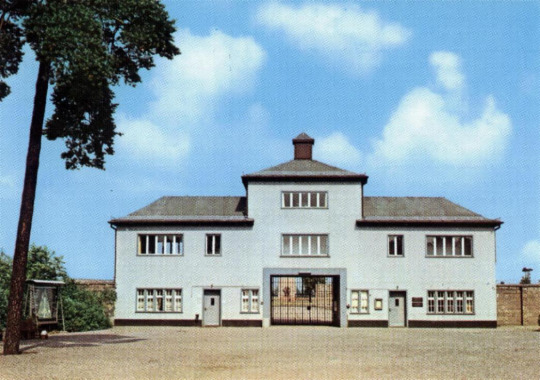
Leaving the photograph collection, I turned toward the entrance to the camp proper and walked through. Arbeit Macht Frei (l2) said the mocking inscription on the gate. By the end of 1944, over 204,000 people had read that sentence as they passed under the lintel and in to the Appellplatz (13). Once inside, more than 100,000 of them were systematically put to death. Others met death in camps they were transferred to. It would be invidious to try to describe the sufferings endured by camp inmates in a purely statistical way; in any case, the destruction of records means that an accurate total can never be known. The information in Sachsenhausen suggests that some 30,000 gay men were sent to the camps under the Nazis. Estimates vary. A figure of 60,000 or more may not be unduly high. Perhaps as many as 2/3rds of these men did not survive.
Standing there, 1 felt as if I had ought to remove my boots and go barefoot. A stupid idea but an almost overpowering feeling. I gazed across the open courtyard, at the monument towering beyond, and was filled with unutterable sadness.

The camp is laid out like a gigantic triangle, with the gatehouse in the centre of the baseline. Emotionally, I felt this to be an obscene joke. Apparently, it was simply the result of Nazi thoroughness and the exigencies of security - a shorter perimeter, fewer watchtowers, fewer unobserved corners, better sightlines. All so easily calculated.
The courtyard presented a large semicircle - the placement of the first row of huts being indicated by a latticed wall. Behind me, to my left and right was the neutral zone (actually a killing field); a wire boundary marker, a few yards of bare earth, then an electric fence. Finally, and almost superfluously, there was the perimeter wall with its barbed wire crown. To step over the marker invited being shot without warning. Photographic evidence shows that some prisoners chose this. Still others crossed the death strip and embraced the electrified wire.
I looked down at the map in my hand. It was difficult to use it nimbly because of the cutting wind and my chilled muscles. My eyes were watering, too, but I could not blame the wind for that. The ribbons on the remembrance fluttered; the only colour in the landscape.
Immediately in front of me was a great concrete roller that weighed three metric tonnes. The Häftlinge (14) were forced to run pulling this and were beaten if they moved too slowly. A semicircle just in front of the first row of huts was identified as the Schuhprűfstrecke (15), Here, in a broad arc, were nine sections - each of a different surface - gravel, flint, broken stone, sand etc… Prisoners had to walk over these for ten hours each day (about 25 miles, carrying 35lb in weight) to test the durability of shoe/boot soles. I looked down. The frost-frozen ground cracked beneath my own booted feet and I sank into the mush. Scattered snowflakes flitted by. A few rooks called, screechingly.
A party of British teenagers came in through the gatehouse. They were chatty, boisterous, as kids are. But their voices grated on my ears even more than the shrill rooks. Some places in the world must only ever be silent places. Not because noise is a bad thing.
No, Act Up is right when it says that Silence = Death. But in Sachsenhausen the silence is needful. It is what makes it permissible to be noisy elsewhere. If the potent and clamorous silence of that place is ever trodden underfoot, then the laughter, songs, protests, whistles and dancing that enliven and affirm us wherever we are will be themselves in danger of being silenced forever.
There are those who wish it so.
In September of 1992, a number of individuals broke into the camp and burned down two of the huts (known as the Jewish Barracks). It is thought that this act was a deliberate desecration of the memorial and was an indication of the resurgence of xenophobia and anti-Semitism in the recently re-unified Germany. In Berlin itself, on Oranienburger Strasse, stands the recently restored Neue Synagoge (16). It is guarded by three armed policemen and is protected by stringent security measures. Inside is an exhibition that focuses on the history of the Jewish people in Berlin, even so, it acknowledges that racism and prejudice have deep roots are widely prevalent.
Closer to home, there is a latent racism abroad on the streets of my own town. The National Front has contested, and continues to be active, in local elections. Dispersed asylum seekers meet with thinly veiled hostility. In 1994 an NF candidate was successfully elected in local council elections on the Isle of Dogs, London. Jewish cemeteries are regularly vandalized. Violence directed at lesbians and gay men, is, sadly, an unremarkable occurrence.
My train of thought had been interrupted by the noise of the school kids, so I allowed them to go their own way and then turned my attention back to the map. Over to the right was a temporary exhibition that told the story of the Jewish Barracks and their inmates. The future of these two barrack blocks (38 and 39), destroyed in the arson attack, remains to be decided.
Further on was the special detention camp set up for prominent political, and other, prisoners. A number of the cells are still there. Prisoners were often held in solitary confinement for long periods, tortured, denied food and drink, kept in darkened cells for months or even longer. Martin Niemőller (17) was a prisoner here. To walk along and look into the tiny cells (some with memorials inside) was a humbling experience. It was not hard to imagine the clang of steel doors, the turn of keys, the sounds of brutal interrogation echoing down the narrow corridor.
What was the date again?
At the far end, the building opened on to an exercise yard, separated from the rest of the camp by a high wall. I stepped out again into the bleak, dismal light. To the left was the Erdbunker (18), a burial cell or pit where prisoners were virtually entombed, exposed to bitter cold and oozing wet walls with only a small, steel barred hatch above.
What would you see from inside? A cross hatched patch of blue? A slate grey torrent?
On the February day I was there, the ground was waterlogged. I could hear the drip of icy melt water as it fell into that dark maw. A great puddle surrounded the hatch, frozen on top, squelchy underneath.
Just beyond the bunker, on the wall, was the memorial plaque that I had come to see; journey’s end for the beribboned remembrance, journey’s beginning for my living remembrance. The plaque is a stark in its simplicity: a black rectangle with the letters punched out by stencil, exposing the wall behind. On the ground below, a few tiles, and, scattered on them, a few carnations. Had they once been pink? The wording of the memorial was as stark in its simplicity as the plaque itself. How else could it be? How can you dress it up in fine language?
TOTGESHLAGEN
TOTGESCHWIEGEN
DEN
HOMOSEXUELLEN
OPFERN
DES
NATIONALSOZIALISMUS
Taking hold of the remembrance, I drove the pole in to the ground as far as it would go and then banked up the mushed, sandy, ice-filled soil around it to hold it steady. Not caring whether I was observed or not, I knelt down in the waterlogged yard,
sank back onto my haunches and waited quietly for about the length of time it takes a man to walk a mile slowly. Everything was hushed. The ribbons flapped and the poem waved about as the wind caught it. For a moment or two, there was a dancing rainbow
When the time was right, I stood up to continue my journey. (I returned to the remembrance before I finally left the camp, the hard frost meant that the banked earth at the base of the pole was already beginning to freeze. Almost as if to ward off the chill, the freedom ribbons fluttered gaily. This optimism made the leave-taking that much easier).
I moved on item the exercise yard to the exhibition mounted in the former prisoners’ kitchen. The route took me past the sites of the gallows where prisoners deemed to have committed offences were hung,. Other grisly punishments were also meted out here during roll call "pour encourager les autres". Away to the right, by the perimeter wall stood a monument to those who died in the camp during the period 1945-50. For Sachsenhausen's infamy did not end with the war's end. The Soviets operated the site, under the name of ‘Special Camp No. 7’, and imprisoned former members of the Nazi Party, members of the SS, and the Wehrmacht (20), as well as prisoners of war released by the Western Allies, and others. Later on, inmates included people who were victims of denunciations, people who were arbitrarily arrested, growing numbers of Social Democrats, Christian Democrats and Liberals, opponents of the Soviet occupying power, and of the emerging East German Communist regime. It is estimated that 20,000 people died as a result of the conditions in the camp..
The sights that met the eye once inside the former cook-house were stinging. Further calculated horrors, to which the prisoners were subject, were held up for unwelcome yet necessary inspection.. There were artefacts from the wartime history of the camp – Zyklon B canisters (21). Human hair, gathered for use as war materiel. Fillings from teeth.
Striped uniforms, with their triangles of various colours (22). Plates and cutlery, stamped with prisoners’ numbers. The ‘height measurer’ from Station Z (23). This building was a place I wanted to run through quickly and escape from. Instead, I walked slowly and deliberately through it all, step by step, case by case, from one information board to the next. It was like the Stations of the Cross. Is it realistic to hope for a Resurrection? ‘Can there be lyric poetry after the Holocaust?’ someone asked.
Can there be?
I do not feel able to answer that question. But I can witness to this: the even in Sachsenhausen it proved impossible to crush the creativity and aspirations of the human spirit. Prisoners crafted necessarily small but beautiful things from the most basic materials and contraband. They made chess sets, inlaid cigarette cases, even a crude radio receiver. Furthermore, there is at least one recorded instance of resistance, carried out by the ‘Jewish 18’. In the autumn of 1942, in protest at their inhuman treatment, eighteen Jews staged a protest in the Appellplatz. Their act of resistance, though brutally suppressed, did result in some amelioration of camp conditions for the Jewish inmates. It did not save the 18 from Auschwitz-Birkenau.
When I had reached the end of the exhibition I paused for a long time by the visitors’ book because had to frame carefully what I wanted to write there. What response can on make to such horrors?
"Whereof one cannot speak, thereof must one remain silent", noted Wittgenstein in his philosophical investigation of language. He must have been thinking of the situations that test the boundaries of human experience when he formulated that precept. And here was I in such an extremity. Just how do you write down a howl of anguish in the soul?
When I left the block I saw the great monument towering before me. I went up close and looked at its huge bronze figures and its concrete vastness. The scale was so big as to be scarcely human. In a way, this is perversely fitting since the dreadful events to which it testifies are equally vast in scope and inhuman in character. The sculpted group of figures at the base of the tower is entitled "Liberation". (A secular version of Resurrection?)
Feeling tiny, I turned and walked the short distance to the site of Station Z.
If Dante's Inferno is taken as a metaphor for Sachsenhausen, then Station Z may be thought of as the deepest and most damned region of that place. Perhaps it is fitting that this was the last place I visited and the place where I most nearly lost what measure of self-control was left to me.
The area is shielded from the elements by a canopy. The suffering and the loss are recalled in an affecting monument; bronze figures two adults with a dead child. More affecting still are the remains of the building that stood on this spot. It was built in l942 and was staffed by the SS. Here thousands upon thousands were gassed, or shot. Their bodies were profaned (treated as the source of raw materials for the war effort) then burned. Any remains were crammed into a subterranean bunker close by.
Given what preceded death, this can be no real surprise. Often, camp inmates were used as a slave work force for various SS-run enterprises. Prisoners from Sachsenhausen were compelled to build the canteen and recreational facilities, used by the Gestapo and SS, on the Prinz Albrecht Terrain (24). In the 'hospital' prisoners were used in experiments to test drugs, chemical weapons, and 'treatments'.
The foundations only remain.
No access is allowed: visitors look through a wire fence on to the features that rising up from the earth. Clearly discernible are the rooms that comprised the gas-chamber (disguised as a shower room) the ante-room where prisoners stripped before going in to the 'shower', and the ramp where the dead, having been thrown on to carts, were pulled the few yards to the crematorium.
Also evident were rooms used for interrogations and a killing room made to appear like a clinic. Prisoners were stood against a height measurer attached to a wall. (A wooden finger that ran between two slats, marked off in centimetres). Unknown to the inmate, there was a hidden room behind the wall. Once the wooden finger was upon his or her head, someone in that room would shoot them in the back of the neck. Bodies were dragged across the floor and through a door that opened on to the crematorium.
All so convenient, so duplicitous, shielded from the eyes of the other inmates.
But there could be no secrecy; the smoke, the smell, the miasma, the point of no return.
It must have been evident for miles.
The wind whipped up again. Steam rising from the boiler house in the old laundry block caught my eye and was transformed into the smoke from this charnel house. It was suddenly 1944 again. The camp was filled beyond capacity with the enemies of the Reich, 90% of them non-German. There were representative groups from virtually all of Nazi occupied Europe.
Russian prisoners were being systematically exterminated. Food was scarce, warm clothes scarcer still. Prisoners were beaten, worked to death, tortured, subject to crazed experiments.
The rooks sent up a cacophony of cries that brought me to myself again. Here I was, in 1996, looking& back at what had been. Statistics in Sachsenhausen indicate that there were more than 2000 concentration camps, sub-camps and detention centres in Germany alone.
I blinked back tears as I looked through the fence and reconstructed these terrors in my mind's eye. Walking round the site, moving clockwise past the sculpture in the near left hand corner, I caught site of a feature that I did not immediately recognise and so moved closer. Suddenly, even through eyes misted over, it became all-to-evident.
The few courses of bricks, the metal doors and the flues, resolved themselves into ovens. There were four in a row. I was absolutely stricken. My legs buckled and I let out an involuntary cry as I stumbled and reached out for the wire to support myself.
From then on, I was in a daze. I tottered across the frozen earth and picked my way gingerly down the trench that led down to the bunker where the bones had been dumped. Signs on the sides of the wooden ramparts indicated where prisoners of war had been shot. Others who met their death at this entrance to Hades included those sent to Sachsenhausen by Reichssicherheitshauptampt of the SS and the Gestapo (25).
Most sickening was the mechanised gibbet, worked by a winch and pulley, which allowed four people to be hung at one time, with the minimum expenditure of effort or manpower. It was what 1 had come to expect of the Nazis during the course of my visit. That I was no longer shocked by such atrocity was a shock in itself. I stared out of the pit at the vast grey sky, punctured only by the concrete finger of the monument. The sky was heavy under the weight of its own sorrow.
The closing scene from the film Judgment at Nurembergcame to mind. An American (small town) judge visits his leading Nazi counterpart whom he has just sentenced for war crimes. The German judge offers, as mitigating explanation, that he thought the Nazis could be controlled and used, that he never imagined it would come to this. His counterpart dismisses this very cogently and simply: "It came to this the first time you sentenced a person to death whom you knew to be innocent."
If Sachsenhausen indelibly imprinted one idea in me, it is this: that every step down the road which begins with disrespect for another person ends at KZ Sachsenhausen. All the sentences which begin, "I'm not …………… (insert your own favourite prejudice)…… but ......" conclude, ultimately, with the sharp report of a pistol shot, or the creak of rope, or the bolts sliding home on the door to the 'shower'.
Many of the entries in the visitors' book say, "This must not be allowed to happen again". My feeling is that it has never stopped happening. I believe that it may prove truly fatal to think of there and then and exclude here and now. I am convinced that the celebration of life and difference, the promotion of human flourishing, is dependent upon us being ever vigilant, and ever respectful of the dignity of others.
My visit to Berlin showed ample evidence that a significant number of people share this perspective. In the wake of the arson attack on the 'Jewish Barracks' at Sachsenhausen, there was a spontaneous gathering at the memorial to express concern and regret. Subsequently, a demonstration was held which focussed on the theme 'reflecting in Germany - together against xenophobia and anti-Semitism'. 7000 people attended.
When the Berlin city authorities were considering what uses the Prinz Albrecht Terrain might be put to, concerned citizens and organisations took an active interest and even direct action, including a symbolic 'dig' on May 5th., 1985. The discovery of the foundations of the buildings associated with the site, particularly the cells used by the Gestapo, and those parts built by the slave workers from Sachsenhausen, together with the insistent pressure brought to bear by those who saw the necessity of an explicit recognition of the role that the site played during the period of the Third Reich, resulted in the opening of an exhibition pavilion and associated memorials which currently comprise the site. The motto of the groups coordinating the May 5th dig seems very appropriate: "LET NO GRASS GROW OVER IT!"
The city is notable for the number of memorials and plaques that detail the location of many buildings, and chronicle many events, which some would rather forget. Berlin's insistence on facing up to the past and continuing to confront it in the present struck me very forcefully. Less formal but no less striking is the graffiti that can be seen in the city. Particularly in the workers residential areas, like Prenzlauer Berg, graffiti appears to be regarded as necessary.
Graffiti ist kein Verbrechen!
Lesben Pauer
Nazis vertreiben, Auslanderinnen bleiben
This is a Nazi house
Much graffiti was focussed on current concerns – Kurdish refugees, the confrontation between Neo~Nazis and their Anarchist and Anti-Fascist opponents. Some was witty and creative but most was political in its inspiration. Amongst my favourites was the pointed reminder: "Wer bunker baut, wirft bomben" (27).
Comparing this situation to that nearer to home gives cause for unease. I do not feel that we recognise the dangers of forgetfulness, or apathy. Remember Pastor Niemöller's lament?
Muted public concern permits our government to play fast and loose with human rights - witness the attempt to expel the Saudi dissident, Mohammed al Mas'ari, to protect lucrative arms deals with the Saudi government. Consider how the Criminal Justice Act is used against travelling people and against those who wish to undertake direct and legitimate protests.
Examine closely those churches who claim to esteem the unique dignity of the human person in absolute terms yet couch their teaching and pastoral documents in such a way that the human dignity of some is completely abrogated. This may be noted particularly when the churches address themselves to women’s issues, lesbian and gay issues, or issues of race and ethnic origin. There is no comfort to be had in looking at the wider situation - the former Yugoslavia, Iraq, Chechnya, or Rwanda.
I wish I were able to claim for lesbians and gay men some innate virtue that renders us impervious to the propaganda of racism and sexism, but I can't. Though we may identify more strongly than some with the women, children and men who were butchered there and then in places like Sachsenhausen, and though we might feel their suffering acutely and recoil in genuine horror, still that does not confer an automatic immunity to the hateful thinking patterns that produced the concentration camps.
If it is true that lesbians and gay men (among others) have a 'privileged' access to the experience of the Häftlinge, then we have a particular responsibility to be vigilant. The danger we face because of that propaganda and its attendant terrors may be more subtle and understated in Britain than it is overseas but it is no less invidious. We must be vigilant not simply to prevent the virulent return of those values that consigned us to the camps (the fear of being inmates in the here and now) but also to prevent us from being seduced by the simplistic slogans and false promises that would make us accomplices in their institution. Without such vigilance we face the awful an almost unimaginable possibility of being deceived into acting as the new guards.
The lesson that Pastor Niemöller learned (too late?) was that if it could be you, it could be me, and if it were me, then it could be any of us. For that reason the same thing is demanded of each of us:

Vigilance and respect; there and then, here and now
2001 © PD Entwistle
Notes
(1) S-Bahn Friedrichstrasse:
Berlin is served by a variety of train and tram routes. S-Bahn refers to the Schnellbahn - the overland train network, Friedrichstrasse to the station in the centre of the city.
(2) Siegessäule:
Victory Column, built to commemorate the military victory over the French which led to the founding of the Second Reich in 1871.
(3) Nazi:
NSDAP Nationalsozialistische Deutsche Arbeiterpartei. The National Socialist German Worker's Party. Elected to power in 1933, the party began to usurp the power of the state, supplanting the rule of law and government by the fiat of the party and the instruments of terror it wielded. Within a few months Hitler had stifled all opposition and abandoned any pretence of democratic rule.
(4) Anhalter Bahnhof:
This was one the chief railway termini for Berlin. Severely damaged in wartime bombing, there now remains only a portion of the facade.
(5) Reichsfűhrer SS:
Himmler’s official title, ‘Reich leader of the SS’. The SS (Schűtzstaffel) was the Protection Squad of the Nazi Party.
(6) Gestapo:
Geheime Staatspolizei, the secret state police.
(7) KZ Sachsenhausen:
Konzentrationslager, concentration camp. In the earlier years of Nazi Germany the camps were sometimes referred to as Schutzhäftlager, protective custody camps.
(8) Remembrance:
This had its origin in two distinct items which seemed to belong together as a 'token' that could be taken to Sachsenhausen and left at the memorial there. The remembrance consisted of 6 freedom ribbons, in the rainbow colours, attached to a pole. These ribbons had been part of a larger banner that had been carried on the Lesbian and Gay Pride March (London) in the summer of 1994. Together with the ribbons was a poem (see below).

The Colour of Forget-Me-Nots
rose pink
carnation pink
perky pink
panther
champagne pink
in the pink
lily the pink
lipstick
blushing pink
candy floss pink
baby pink
bootees
marshmallow pink
bubblegum pink
fuchsia pink
Triangle
(9) Gedenkstätte Sachsenhausen:
Many of the former camps have been designated as places of national remembrance and reflection. Sachsenhausen is the one closest to Berlin.
(10) Strasse der Nationen:
Street of the nations
(11) GDP:
German Democratic Republic more commonly referred to as East Germany .
Now, of course, no longer in existence since the reunification of Germany.
(12) Arbeit Macht Frei:
The motto which was found at the entrance to the concentration camps. Work shall
set you free.
(13) Appellplatz:
The place where inmates were assembled for roll-calls, punishments etc…
(14) Häftlinge:
Prisoners of the camp.
(15) Schuhprűfstrecke:
The shoe-testing ground.
(16) Neue Synagoge:
The 'New Synagogue’, completed in 1866. One of two dozen synagogues vandalised and set alight on Kristallnacht (the night of broken glass), November 9th., 1938. Following this pogrom 12,000 Berlin Jews were brought to Sachsenhausen.
(17) Martin Niemöller:
Pastor Niemöller, U-Boat commander in WWI and a one-time supporter of the
Nazis, came to reject Fascism and was incarcerated in Sachsenhausen.
He is, perhaps, best remembered for the following verse –
First they came for the Jews
And I did not speak out – because I was not a Jew.
Then they came for the Communists
And I did not speak out because I was not a Communist.
Then they came for the trade unionists
And I did not speak out - because I was not a trade unionist.
Then they came for me
And there was no-one left to speak out for me.
(18) Erdbunker:
Literally, ‘earth bunker’.
(19) Totgeshlagen…:
A literal translation is difficult. The inscription may be read as –
BEATEN TO DEATH
SILENCED TO DEATH
THE
HOMOSEXUAL
VICTIMS
OF
NAZISM
(20) Wehrmacht:
The German Army.
(21) Zyklon B:
The cyanide gas pellets used in the gas chambers.
(22) Triangles:
Prisoners in the camps were made to wear triangles of different colours. The
respective colours indicated the reason for their incarceration, eg. green = criminal,
red = political offender, black = anti-social, pink = homosexual.
(23) Station Z:
The mass extermination facility, built by the SS in 1942, and run by the
Totenkopfstandarte SS (Death’s Head battalions of the SS). Here, thousands
upon thousands were systematically butchered.
(24) Prinz Albrecht Terrain:
An area of central Berlin that housed the offices and HQ of the Nazi state terror
apparatus eg. the Gestapo, the SS. Bounded by (what is now) the Wilhelmstrasse,
Niederkirchnerstrasse, Stresemannstrasse, and Anhalterstrasse.
(25) Reishsicherheitshauptamt:
An approximate translation would be Head Office of Reich Security.
(26) Graffiti:
Colloquial translations might be –
Graffiti is no crime!
Lesbian Power!
Deport the Nazis, let the immigrant women stay
(27) Wer Bunker…:
Whoever builds bunkers, drops bombs
#holocaust#holocaust memorial day#remembrance#sachsenhausen#concentration camp#gay#homosexuality#persecution#nazism#nazi#berlin#damian's writing
3 notes
·
View notes
Photo

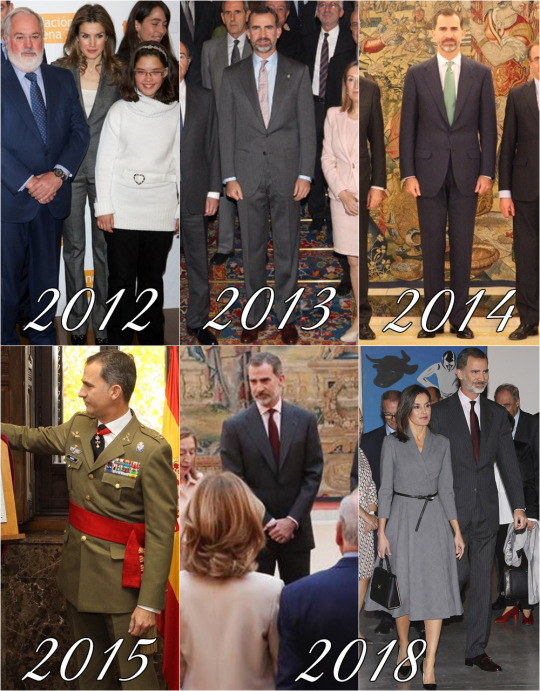


Felipe and Letizia retrospective: December 3rd
2003: Opening of the 8th Iberoamerican Congress of Constitutional Law. Universidad de Sevilla
2007: Lunch & Gala dinner offered to the president of the Philippines Gloria Macapagal-Arroyo
2009: Opening of the 12th State Volunteer Congress & Reception on the occasion of the Conference of Presidents of the European Parliament
2011: Doubles match between David Nalbandian and Eduardo Schwank of Argentina and Feliciano Lopez and Fernando Verdasco of Spain on day two of the final Davis Cup match between Spain and Argentina in Seville.
2012: Antena 3 Foundation meeting in Madrid.
2013: Delivery of the International Spanish Architecture Awards and the Medals of the Superior Council of the Spanish Architects’ Colleges in Madrid
2014: Oath of the new Minister of Health, Social Services and Equality, Alfonso Alonso Aranegui at la Zarzuela in Madrid.
2015: Visited the new headquarters of the Chancellery of the Royal and Military Orders of San Fernando and San Hermenegildo in Madrid
2018: Audience to the Advisory Council of the General Courts for the commemoration of the 40th anniversary of Spanish Constitution at El Pardo Palace & ‘Poeticas de la Democracia. Imagenes y Contraimagenes de la Transicion’ exhibition at the Reina Sofia museum (1, 2, 3)
2019: Audiences with Nancy Pelosi, Speaker of the US House of Representatives; the President of Costa Rica; the President of Argentina; Antonio Guterres, Secretary-General of the United Nations; the President of Austria; Lunch with Grand Duke Henri of Luxembourg; COP25 Climate Summit & Gala dinner for the awardees of “Mariano de Cavia”, “Luca de Tena” and “Mingote” awards
2020: Inaugurated the “Rafael en Palacio. Tapices para Felipe II” at the Royal Palace & Board meeting of the Carolina Foundation
F&L Through the Years: 670/??
#King Felipe#Queen Letizia#King Felipe of Spain#Queen Letizia of Spain#King Felipe VI#King Felipe VI of Spain#F&L Through the Years#December3
10 notes
·
View notes
Photo
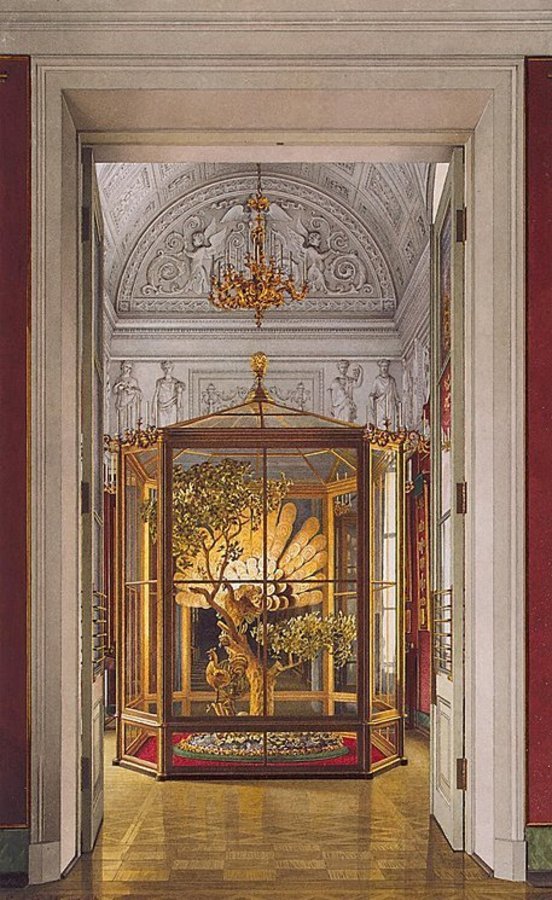

















THE PEACOCK CLOCK IN HERMITAGE
For more than two centuries now the Hermitage has been adorned by a unique exhibit that never fails to evoke the enchanted admiration of visitors - the famous Peacock Clock. The figures of a peacock, cockerel and owl that form part of this elaborate timepiece-automaton are fitted with mechanisms that set them in motion.
The creation of mechanical birds had long been of interest to inventors: back in the Ancient World figures of "singing" birds had been used to embellish clepsydras - water clocks. In the 18th century the makers of automata tried to create a system that would enable their birds not only to sing, but also to behave as if alive, and they made them life-size. In the middle of the century, for example, the whole of Europe admired the mechanical duck made by the French craftsman Jacques de Vaucanson, which was able to eat, drink, move and behave in the most life-like manner.
The most celebrated creator of mechanisms of this sort in the second half of the 18th century was the London jeweller and goldsmith James Cox. His fertile imagination generated ideas that were then turned into reality by the craftsmen and mechanics of his company. Cox's firm produced a large number of elaborate automata, sumptuously decorated in a great variety of ways, for European and Eastern clients. Cox became truly famous, however, when in 1772 he opened his own museum - the Spring Gardens, in which he exhibited a large number of mechanical figures of exotic animals, birds and human beings. To fund the making of expensive automata Cox organized lotteries: in London in 1773 and in Dublin the next year. A surviving catalogue of the Dublin lottery lists two peacocks as numbers 6 and 8. From the description of the items it is clear that this pair of automata differed from the Hermitage composition: the peacock was perched on an oak stump, around which two snakes twined. There is no mention of the figures of a cockerel and owl, or of the mushroom that acts as the clock dial.
The history of the Hermitage's Peacock Clock begins in 1777, when the Duchess of Kingston visited St Petersburg. Balls were given in the Russian capital in honour of this wealthy and distinguished guest. Grigory Potiomkin, who met the Duchess in society, learned of James Cox's magnificent mechanisms. Pandering to Catherine II's passion for collecting, the Prince commissioned the celebrated craftsman to make a monumental automaton with a clock for the Empress's Hermitage. In order to meet this expensive order as quickly as possible, Cox, whose financial affairs were currently not in the best of health, decided to use an existing mechanical peacock that featured in the Dublin lottery. He expanded the composition with a cockerel, owl and a clock mechanism with a dial incorporated into the head of a mushroom, and removed the snakes. To create his new automaton, Cox recruited the assistance of Friedrich Jury, a German craftsman who had settled in London.
The Peacock Clock arrived in St Petersburg in 1781. The records of the Winter Palace chancellery listing the valuables that Catherine II acquired in that year include mention of two payments - on 30 September and 14 December - to the clockmaker Jury for a clock delivered from England. The payments amounted to 11,000 roubles (around 1,800 pounds sterling) and were made from the Empress's personal funds on the basis of a letter from Prince Potiomkin.
The clock was brought to Russia in pieces. At Potiomkin's request the Russian mechanic Ivan Kulibin set it in working order. From 1797 to the present day the Peacock Clock has been one of the Hermitage's most famous exhibits. It is, moreover, the only large 18th-century automaton in the world to have come down to us unaltered and in a functioning condition.
1 note
·
View note